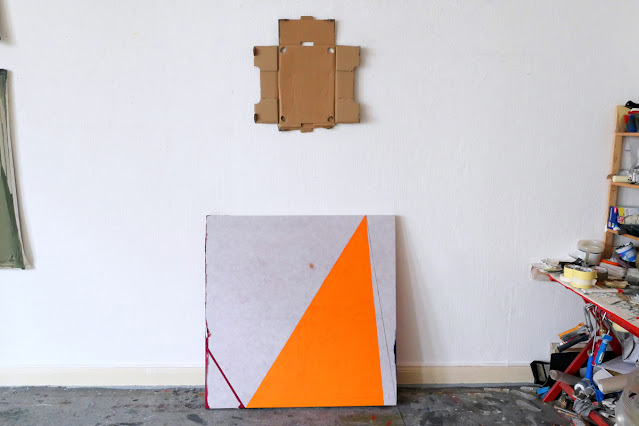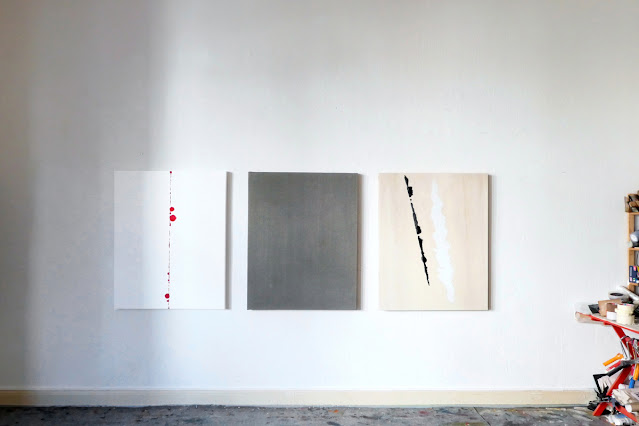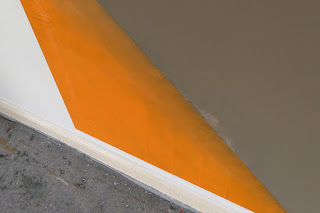 |
Stool cycle, 2021. Each 100x80x4cm (39x31.5x1.6").
|
---
 |
| Signal; another one in twelve of my constricted "stool cycle", started mid-August and shut at the end of September 2021. Each 100x80x4cm (39x31.5x1.6"). Here, oil on sanded gesso on poplar plywood. |
 |
Signal. December 2021. Twelfth and final painting out of my "stool cycle". Each one 100x80x4cm (39x31.5x1.6"). Oil on sanded gesso on poplar board fixed on frame. There are things i've done that I'm not proud of. They are not that numerous and they are trifles, you would say maybe, but they are trifles that matter to me and who take advantage of moments of weakness or inattention to show up at the door and claim their due, little ghosts terribly serious in their bailiff's garb. There are others things that I'm very happy i did that i shouldn't have done, and those matter to me too, but the other way around. Finally, there are things that i would love to do and that i will not do, that i already regret not having done. As far as this painting is concerned, i'm rather happy to have done it and it will speak for itself since i haven't yet been able to measure its implications and therefore draw the consequences.
|
---
 |
| Shaving the white. December 2021. Eleventh and penultimate painting out of my "stool cycle" started last November. Each one 100x80x4cm (39x31.5x1.6"). Here, oil on sanded gesso on poplar board fixed on frame. I tried to make the red-orange motif stay in close relation to the surface, that is, not above, not below, not inside, but "with", despite the thickness of the color in places. It is for this purpose that i did not cover the wooden panel with several layers of gesso until obtaining an immaculate immaterial surface, but that i left the medium partially visible by transparency and also some traces of the tool which i used, a steel thin flexible squeegee. Another difficult painting to photograph ... |
---
 |
Mere nip. Another one of my "stool cycle"; twelve paintings, each 100x80x4cm (39x31.5x1.6"), 2021. Multi-layered sanded gesso and oil on canvas. I titled so since it is the only one of the group for which i followed the vertical; so that, without diagonal or suggestion of diagonal, any explicit or implicit triangulation was evacuated; space therefore only exists on either side of the pictorial motif, and since the whole space had to be involved, i crushed the red on either side of what would otherwise have been only a line; the red was not painted, but transferred by the application of the color from the edge of a masonry ruler; but the important thing was a matter of rhythm to be found.
|
---
 |
| Diagonal. Ninth painting (no timeline) out of twelve in my "stool cycle" (each 100x80x4cm (39x31.5x1.6"), 2021. Oil on multilayered sanded gesso on inverted prepared canvas. Oblivion and remembrance? Slow to forget, maybe ... When my cat is dead (a she-cat actually, and a great huntress, as can seen in the last pic, with The End Of The Sparrow), fourteen years ago, i as they say thought of her (images especially, and tactile sensations) every day unexpectedly during the following ten years with sorrow, but especially with pain, so that i did my best not to go into anything deeper and tried to evacuate the memory as quickly as possible. But it came back and back and back. It was not until fairly recently that i discovered that i had gradually ceased to think about her on a daily basis, that i had ceased to be assailed by those sudden stabs that triggered in me micro crises of real despair. I always think about it, as they say, but less, less regularly and more calmly, to the point where I can write these few lines without wanting to take the plunge. This is what we call, i suppose, mourning a being to whom we were really close, that is to say facing real (or having succeeded in wrapping it up again in an illusion). Even if i continue to find from time to time, here and there in the fold of a sweater or in the clothes closet where it happened she sneaked off, or caught in the texture of the old stained carpet in the studio, a fine hair, gray and tawny, with a very fine end, white and frizzy, that i would recognize among a thousand other cat hairs. |







---
 |
| From either side. Fourth post of my "stool cycle"; twelve paintings, each 100x80x4cm (39x31.5x1.6"), 2021. Sanded gesso on linen. Not easy to photograph, sorry. I cut the ears in order to keep the shape itself as rectangular and as flat as possible, physically and visually, but also to unveil the underlying wooden stretchers a bit. The sanded gesso makes the canvas appear gray, but without the sanded gesso it appears white. |
---
 |
| Partition. Eighth painting of the "stool cycle"; 100x80x4cm (39x31.5x1.6"), 2021. Acrylic paint and oil on sanded gesso on canvas. / Emotion against expression? The difficulty in painting is not to mix the two, to ensure that the emotion remains in the painter and does not come out to flood the canvas. One is tempted to get rid of the emotion by daubing the surface with it, but that often results in noisy things. Emotion is close to sexual desire with which it has a lot to do: we try to lower the level by taking action. What is needed, from my point of view, is to manage to keep it whole and alive in oneself, even if it is painful, so as to leave visible only the expression which is not the ashes of it, but its transfiguration. De Kooning's later works are achieved in this regard, in that they no longer obey impulsively the original drive, which is just begging to be temporarily extinguished in one way or another. The expression of a proper painting, its intensity, comes from this deliberate separation, from this conceptualization of emotions. And killing emotion a priori is not a solution since it brings bleak pieces (even colorful), devoid of the danger inherent in exercise by an excess of caution which is often damaging. Always a matter of balance. |





---
 |
| Fringe. December 2021. Tenth painting out of twelve in my "stool cycle" (each 100x80x4cm (39x31.5x1.6"). Sanded black gesso on inverted prepared canvas. The unique and its double. Mulholland Drive approaches the frontality from an angle, through the diagonal, with the turn. It's always a question of a pivot, around which things move. In this film, everything revolves around women's sex, space folds itself there, it is often at and after the corner of a wall that the important thing is revealed: the one that has no meaning. I've already seen the movie three or four times since he came out and I still haven't understood anything; so it's probably for this "reason" that i'll see him again one of these days. When i got the psychiatrist's report concerning my father, after a "simple medical examination" which had been presented to him as a routine set up by the city for the benefit of the elderly (a subterfuge which it was necessary to implement to avoid the categorical choleric refusal which he opposed to any request coming from the outside ((from the outside of his head!))), i read: "paranoid dementia" as the conclusion of the tests, what seemed to me quite consistent and rational. But afterwards this label recurred to me like a wave going up a beach day after day, again and again, the same and always different, unveiling buried objects which one could not have suspected the existence hitherto. And this wave doesn't cease to have its effect till today, regularly making me unearth additional clues, prints of symptoms dating from thirty or forty years, and that my mother and i had put at the time on the account of a "bad mood" without giving them more importance because we lacked words and grit to organize these marks into a cohesive and significant skein. On the other side, the firepower, the impact and ease with which this diagnosis imposed itself upon us, has been accepted, is also worrying. Writing is unreasonable ... |





---
 |
| Bars. Fifth out of twelve of my "stool cycle" (no timeline); 100x80x4cm (39x31.5x1.6"), 2021. Sanded gesso and oil on poplar board fixed on wooden frame. My current policy (watershed) is thin, narrow and wide. Narrow because colors and shapes are not there to indicate or suggest the existence of another reality beyond themselves, wide because i use for example perspective and depth without qualms, as one takes a hammer to drive a nail, with simplicity and carefulness for fingers. |
---
 |
| Outage. Seventh out of twelve of the "stool cycle"; 100x80x4cm (39x31.5x1.6"), 2021. Acrylic paint and sanded gesso on canvas. A blue narrow slightly diagonal ribbon on and under layers of gesso, tuned and detuned since i need paintings that are as critical as they are self-critical to reach the aim i've set for myself. Peel off the surface from the surface to keep the surface, open the space by separating the parts, but without breaking them, gently lifting the edges of the wound. Thanks to Daniel Feingold, one of whose comments gave me the opportunity to write these lines by answering to him. |
---
 |
| Clinamen. One out of twelve of the "stool cycle"; 100x80x4cm (39x31.5x1.6"), 2021. Sanded black gesso and oil on canvas. Clinamen (declination, tilt, deflection) is a pretty pretentious title, i'm afraid ... In Lucretius's writings this one explains that contrary to Epicurus' view atoms do not fall into the void of space in a straight line, but, tilting slightly diagonally, can collide to each other and produce bodies, things, phenomenons. It is this deviation from the fall that breaks the laws of fatality and prevents the causes from succeeding each other ad infinitum. |
---
 |
| Disclosed rows. Second post (no timeline) of my "stool cycle": twelve paintings, each 100x80x4cm (39x31.5x1.6"). Diluted acrylic paint on flipped prepared canvas. I intended to go further actually, but the texture, the structure and the lines of the result made me stop. It wasn't just a background, it was the painting itself, revealing its potential, since with the rarefaction of elements the slightest gesture can be decisive, because it's not so much what you add, it's what you don't do that produces or unveils the painting itself; here at least. The play of pigment and canvas, wet and dry, revealed not only the singularity of the substrate, but above all what happened in the implementation. But this is only one of the methods allowing to breach the space and to open the painting to its own emergence. Either way i would be pleased to reach that point where one no longer says: it is there, but: it is, or: it, or: is, or: that ... |
---
 |
| Inner margins. First one in twelve of my constricted "stool cycle", a summary which started mid-August and shut at the end of September 2021. Each 100x80x4cm (39x31.5x1.6"). Here with oil on multi layered sanded gesso on linen. No canvas texture, except in the central vertical. The sanded gesso, layer after layer in the wet, acquires a density and a fineness which magnifies its very balanced color, never blinding; a white which doesn't push himself forward, which dematerializes itself but stays on the surface; maintains the surface; doesn't deny the surface; well, then, surface. |
---
 |
| This, is that (or The comma). Each around 41x33cm (16x12.6"), multilayered sanded black gesso on shaped sanded thin plywood fixed on stretchers, September 2021. Regarding the left piece, cut irregularly on the right, the dimensions and the position of the anthracite coat precisely trace the dimensions and the position of the frame glued below. It is therefore a kind of counterfeit transparency. On the right piece, the flare of the cutout is also indexed to the underlying frame, and deviates from it diagonally a centimeter more than elsewhere at the top right. Therefore it's not that the photo is taken at an angle, it really is like that. |
---
 |
| Extent and Measure, 2021. / Extent, acrylic and oil on canvas, tondo Ø60cm (23.6"), 2021. / Measure, acrylic on cardboard, 340x45x15cm (134x17.7x6"), 2021. / Maybe one day an unbelievable discovery will change one more time our minds about the shape of Earth, which will no longer be seen round and blue like an orange but once again round and flat like a pancake (painted on both sides). Anyhow anyway, extrapolating, we have to stay aware that what we believe in doesn't exist, because it is the mark of belief to make people believe what is not happening, or more precisely doesn't have to be believed. Because otherwise why would we have to believe in? The mere presence of this question ("To be believed, or not to be believed?") is enough to destroy any claim of belief in any truth. Doesn't belief manifest itself above all and by definition by its absence of proof? Ultimately, the best thing, perhaps, is not to really believe what we believe to be true, what we tend to believe. Well, then, in all circumstances, staying as cold as a grave full of embers. |









---
 |
| Untitled (seven little oracles and some triangles), August-October 2021. Each 30x21cm (11.8x8.3"), with: gesso, black gesso, oil, acrylic paint, acrylic sealant, tape and oil stick on sanded poplar plywood fixed on smaller size stretchers, + one folded painted cardboard 70x57x46x52 (27.6x22.5x18x20.5). / The advantage of painting on a thin plate fixed on a smaller support is to obtain, after a few tests, an adequate ratio between the dimensions of the panel, its thickness and the width and density of the shadow underneath. This so called "adequate ratio" gives the entire surface the same status than what is painted on it. In other words the panel itself becomes a dynamic pictorial element, not a conventional material traditionally intended for painters. The absence of canvas on stretchers also resolves the issue of edges. Here everything is already sharp. The gap between the wall and the board, if not of an exaggerated thickness, simply clarifies the proposal, since it is not my intention to mysteriously float the panel in the immaterial space of a metaphysical theology (even if i must admit that the subtitle of this grouping isn't without biblical emphasis in a way, shame on me). / And in addition a quote that has nothing to do with the work itself but which i find quite hilarious coming from a bank (Royal Bank of Canada), and remarkably well articulated. "Wisdom also urges modesty, and yet we the people evince approval of egregious blowhards in the media by helping to make them famous and fabulously rich." (Linguee's examples) |









---
On wood, October 2021, each 40x50cm (19.7x15.7"), sanded gesso, acrylic paint and oil. -- Anew busy with this affair of "opening the surface" and also of maintaining it in all its parts, as well as of ensuring that the painting involves and holds (even rules) the surrounding space, that the painting actives the perception beyond the limits of its surface, not as an image or as an object, nor as a commodity, but "by its own ability for a tempered radiance" (i quite like this fuzzy wordings, which contrast, at least i hope so, with the kind of aesthetic stringency i try to implement). Modifying perception without destroying its bases by a conceptual or perceptual coup de force is a full-time job when one doesn't believe in originality, since everything is based on repetition; repetition of reproduction and reproduction of repetition. - Linguee's quote of the day: "The crew members then cut the painter, guided the life raft after, and made it fast to the fishing vessel."
---
 |
| Little exercise aimed at establishing the existence of the tape by the pictorial evocation of some of its visual and tactile properties by means of observation and memory, or: The tape you cannot remove. Each 50x50x3cm (19.7x19.7x1.2"), acrylic and oil on canvas and linen, early 2021. I had planned to write precisely the whole procedure of the one on the right, in eighteen points, but the space left for comments is insufficient ... pity. Short version: by placing two stripes of tape close to each other in order to draw a fairly strict line between them, i had observed since a while that by crushing oil color on this line with the finger, the color, in overflowing on the tape, can create a fringe, a tear, a scuffed cut, or whatnot, whose direct, delicate and precise quality was due to the very fine texture of the tape, and which i could never have obtained by proceeding directly on a canvas. So i got it into my head to experiment it, that is to say to paint a fake tape in a way, but without going so far as to reproduce its aspect itself in its smallest details, since it wasn't my purpose. |






---
 |
| Untitled (upright), each 40x30cm (15.7x11.8") i believe, since i'm not at home these days and cannot measure them precisely. Acrylic paint and oil on canvas, September 2021 and mid 2020; a new one, one reworked. Usually i don't shoot paintings with neon light (although often the colors are closer to the original) because it dematerializes the work and creates absurd shadows, logical shadows but of artificial appearance; from my point of view daylight is the best for painting, as it reveals the subtleties of a surface, a texture, a shade, a tint; however the Berlin sky was so gloomy at that time that i had to override my reluctances. Linguee's quote of the day: "When drilling into a wall, do not damage electrical wiring and other hidden utilities." |
---
 |
| Extent gauge, 184x184cm (72x72"), diluted lacquer paint and oil on canvas, 2021. |
---
 |
| Artists have to come to terms with an unnecessary being. Indeed, no one needs their art because art is useless. They must therefore transform a potentially tedious, even painful situation and make this uselessness an asset, a motor, the center, the void to which they can graft and nourish their capacity for renewal. That last sentence is particulary silly, but you know what i mean, as they say. It is a question of generating a quality out of a lack, and even if i don’t feel any holistic affection for artists, who generally turn out to be monsters of egoism and indifference, i concede that it is not so easy to solve some matters specific to the job. Here, neither egoism, nor monster, nor indifference are to be understood in a derogatory meaning. This is like saying that a rabbit often holds rather long ears, or that a cyclist often possesses a bicycle. You might think i'm exaggerating, but a rabbit knows rabbits ... |
---

|
| Possible configuration settings. Right painting (untitled): 40x40x3cm (15.7x15.7x1.2"), oil on wooden painting board, September 21; left painting (untitled): 50x50x3cm (20x20x1.2"), oil on canvas, August 21; and acrylic paint on cardboard in addition. / Generally when doing something with cardboard i transform the original shape, not only by color, but by bending, cutting or tearing the material, but this time i refrained from it, then it only plays a role of integration and separation of the two paintings, respecting their verticality so to speak. This cardboard piece remains, painted and partially folded, what it was: a large moving box. Naturally the hollowed-out handles, in contrast to the white of the wall, and by their repetition almost become a motif. The paintings were slow to come, months actually, but they look tolerable now, although the painterly aspect of the blue one gives me pimples ... |
---
 |
| Slippers, black gesso on canvas, oil on wood, 2021. |
---
 |
| Our book is out! Laurence Grace/Michel Carmantrand, Editions Crise et Tentation, Paris, 2021. |
 |
Partage des murs (sharing the walls), by Laurence Grave (@grave.laurence) and I. Not too large, not very expensive (13 Euros, free postage), consistent and well printed: 110 pages, texts (French) and photos. It can be ordered directly from Crise et Tentation publisher (link in bio, up). I chose thirty photos of Laurence's works and i commented on them, she did the same about me. Preface by Victoria Le Boloc'h Salama (@victoria.lbs); introduction by Marcel Fontaine; afterword by Daniel Feingold (@danielfeingold ((do not hesitate to ask Daniel to send you the English version of his relevant essay) including a quote from Coskun Demirok (@coskun_demirok). A big thank to our publisher Georges Goncalves (@editioncriseettentation) and to the graphic designer Alexandre Chenet (@alexandrechenet). |
---
 |
| Untitled (from on either side), 60x50cm (23.6x19.7") and 50x40cm (19.7x15.7"); left: acrylic paint and gesso on wooden painting board; right: oil on canvas on stretchers restapled on a bigger frame later gessoed and sanded, September-October 2021. |
---
 |
| Inverse, Ted, 2021. |
---
 |
| Grouping, August-September 2021. |
---
 |
Umbrella, acrylic paint on tarp, 2021. Of course a chair, or a pic of a chair, isn't there only to demonstrate a scale or to sit on. A chair also attests to the stable state of the world, with a soil below and a sky above, unless it is found upside down or with a foot less; just as a dining table for some of us at least is part of a certain vision of the house, home, group, of what it is called a community. As well as a pair of shoes provides precious insight into his or her owner. And it is not to forget that a hammer probably derives from the cudgel. So most objects are not reduced at all to their function of use and sometimes even, quite the contrary, their meanings and sense go far beyond what they are used for and what they were made for. Words, notions, concepts arise in the same way as chairs. I believe i would like to do an exhibition entitled The chair, where that one would be accompanied by a few fairly large paintings and one or two other objects designed for the occasion. As a provisional conclusion, an object is not an object, a chair is not a chair and a painting is a chair. Second provisional conclusion : what we believe we see is not what we see but that how it stares at us.
|








---
 |
The shareholder and the eccentrics, 2021-2019-2013 (reworked, improved or transformed some old ladies), 90x90x4cm (35.4x35.4x1.6")+85x85x4 (33.5x33.5x1.6") + 61x61cm (24x24")+40x40x4cm (15.7x15.7x1.6"). Acrylic paint, oil, cutout, canvas, stretchers. It has been known since the first operations of bisection of the brain that the cerebral hemispheres can operate simultaneously, independently. The psychological criterion of identity then ceases to be associated with the brain taken as a whole; this prompted the following note: if each cerebral hemisphere harbors personal identity, then every human being is potentially two people. (Oh, my God!) The neurologist Roland Puccetti concluded from his works that two people live in us and work together without one being aware of the other's existence. I have not read the texts of Mr. Puccetti, but it seems to me that from early childhood each of us knows already that we are a whole group in there. It is only afterwards, under the pressure of circumstances, that we begin this slow lifelong work with its impossible outcome, trying to be only one.So, apart from these respectable nonsense (which i consider quite vulgar, however), we can tell ourselves that we don't necessarily need to cut us the brain out to tackle the mystery of identity.








---
I am taking advantage of what is almost still the start of the year to take one or two verbal resolutions. Because i am inhabited by language. If i wasn't inhabited by language, i wouldn't paint. Program 2021. First: to spare the affects, to leave them only a small opening (in order to intensify them). Second: no feelings. Well, this personal perspective having been verbalized, about the world in general i suggest the blanket ban on religions and advertising. My estimate of the gain achieved by this ban would be a drop in stupidity of about at least 50%, with all the beneficial consequences that one would have the right to expect from such a revolution. We will deal with the urban dog poop problem another time. Everything in its time. But it is certain that the production of plastic bags intended for this use is not the best solution either, in relation to the environmental pollution generated by their massive use.
Watching matchine: oil, black pencil and blue Bic pen on reversed inverted and cut out oilcloth, 100x100x4cm (40x40x1.6"), 2021. La peau de l'ours: unfolded cutout and stapled tangerines cardboard crate, 54x54cm (21x21"), 2021. |
---
 |
| Restrained burning, 185x185cm (72.8x72.8"), acrylic paint and oil on canvas. |
---
 |
| Grouping II, 2021. |
---
At the end of the End, a few months ago, late 2020, after having completed it, achieved it, looked at it, watched it, suspected, observed, auscultated, weighed, measured, questioned, contemplated, admired it and saw that that was good, i photographed the painting, carefully wrapped it in cosy bubble sheets, neatly stored it away and posted ITS Image on Instagram in order to celebrate ITS eternal glory.
However, a few weeks later, i began to think about it again and was seized with a slight feeling of sporadic discomfort ... But he didn't unwrap the painting. And that uneasy feeling grew and grew and didn't leave him in peace anymore, since it was coming back, and back, and back ... But he didn't unwrap the painting. Finally, he couldn't stop thinking about it: he had got a doubt! And thirteen Sundays later, one Sunday night before the Monday he had a dream in the middle of the night and he stood on top of a bare mountain and a loud voice telling him that the right side was weak, flabby, lazy, and so on ... So, coming down from the mountain, he added a thin ribbon of blue, straight and strict in its way, which extracts the negative counterform and increased the participation of the shapes to the whole of the surface (or even better, rather the reverse). And he saw that that was good. Pictorial motiv, 185x185cm (72.8x72.8"), diluted lacquer paint, acrylic and oil on canvas, 2021-2020. |
---
 |
| Grouping |
---
 |
| Spring tulips, 2021-2019. Reworked these two ones. From one painting to another, from one body of paintings to another, from one day or from one year to another, from one decade to another, it's like judo or this kind of stuff, placing accents, finding the sequences, making the articulations play in order to keep the overall gesture oriented towards its goal, which is also its beginning and or beginning again ... and so as not to fall into nature and into the odious authenticity of resemblance (without speaking here about figuration, but about repetition), introduce artificiality, detune, discard the eyes. "Blow your eye!" shouts Achab, "There she blows" answers the sailor. What about "Blow your blows"? ... To make a painting that holds out, thinking not in terms of surface and two-dimensionality, but in terms of volume and in terms of speeds and or intensities. Speed here is not time, but movement in volume. If i manage to make velocities and / or intensities coexist in this volume, then everything is organized. To paint a square on a square of canvas is not to paint a square but to paint in a cube of various streams. To reach the depth of the surface, having to row against my tide, nobody's there. ... The form as a momentarily crystallized result of the deformations of its environment. A precipitate, a hollow shape, a negative of the signifier: the form as deformation of the prerequisites and the presuppositions that surround it, iced combustion. ... Last pic, Herman Melville. |





---
Topical rain (or The crownless king), 185x185cm (72.8x72.8"), diluted lacquer paint, acrylic paint and oil on canvas.
---
 |
| Grouping |
---
 |
I seize the opportunity (by its long curly hair) from this incongruous neighbourliness to present you the latest version of PARTITION II (alongside ROOSTER BY MOONLIGHT, which will be to be seen one of these days to come). I wasn't entirely happy with what looked from a distance like a red line, so i partially transformed it. PARTITION II: 170x170x4cm (67x67x1.6"), priming white, pigments, sanded acrylic paint and oil sticks on linen on canvas, 2021-2020. This red line gave me a hard time ("donner du fil à retordre", in French). Drawn first with oil stick, it seemed later too easy to me, in its comfortable and attractive tension (the pretty chick in her short red skirt). So I decided to accentuate it, because i noticed that, often, one can attenuate, even cancel a power by increasing it, paradoxically. At least in painting. It was reworked with oil paint and brush; but then, the resulting visual cut of the plane seemed to be too natural and too sharp together. Also i added here and there red nodules (or small kidneys) which i crushed under a transparent flexible plastic sheet (soft tarpaulin for the protection of furniture in case of domestic painting), the ones oriented above of the line, the others below, in order to integrate and capture the entirety of the surrounding white space. But as it dawned on me one night a month later, thinking about it and then unwrapping it in the morning to confront my nocturnal impression with my daylight eye, it was not enough: the painting was still suffering from esthetico-moral stiffness in the joints (an old spinster with lips too thin and too tight on unspeakable secrets of no importance at all to anyone other than her) and i took the brush, modulated and widened a portion of the rouge below the "line", so that this addition does not come into too direct conjunction with the blue vertical. PARTITION, the first one, stands at the end of the set.




---
Daddy Mummy the maid and me (Papa, Maman, la bonne et moi), 30x24cm (12x9.5") each. Cutout, gesso, collage, acrylic sealant, acrylic paint and oil on linen. And now, let's trip over uneven steps in the stairs: Picabia was used to say that ideas are like shirts, that you have to change them from time to time (but to affirm this, it is necessary to have a thought, a single idea, underlying and intended for invisibility); finally, maybe a painting is this void, always the same, whose existence and location are designated by a painted shell, often made of wood, canvas, metal or other; the most interesting thing about sewing is that the thread disappears; and the snow snows.
---
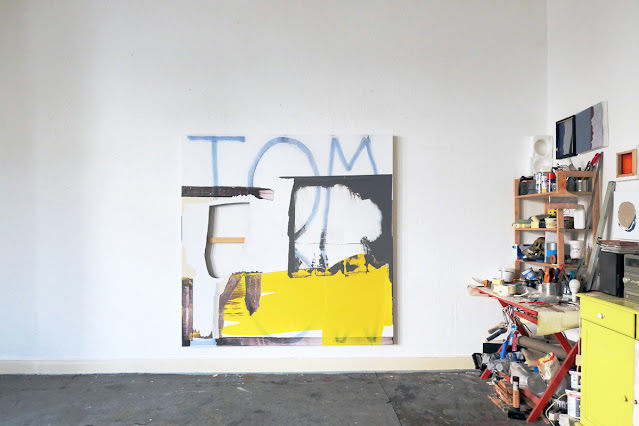 |
| Mind the gap (Tommot), 170x170x5cm (67x67x2"), acrylic paint, cut, spray, gesso and enamel on canvas. As some
buddy kindly pointed out to me recently that from one painting to another we
didn’t know to whom to attribute this one and that one, so much did they seem
at first sight to come from different hands, i got the idea to write a word
about that. Well, i don't have eternity, i have to take long strides if i want
to carry out seriously my work as far as possible, which may partly explain some ellipses. Say these are shortcuts that allow me to
go directly from one joint to another without having to travel the entire
length of the bone. It is true that serial likeness may be a pertinent classical strategy,
as it will be easier for a gallery to sell merchandise that looks like the one
already sold, but actually i don't really care about getting rich and
famous (famous people are constantly bothered, rich people are constantly
tormented by the fear of becoming poor) and somehow i don't really care about
figuring in the history of art for History is too often a lawyer lie ... But since my father passed i can pay the rent without having a job or depending on the sale of a work, it only
matters to me that each painting expresses my intentions as well as possible,
whose will testify the materials chosen and the method used for their implementation,
which however will not become the subject of the painting, because i maintain
the image and do not intend to reduce the result to its only components, even
if i find that this approach is sometimes necessary to get rid of an overflow of
sentimental sticky imagery. But to come back to this painting it's funny to note how this particular shape, here cut out
of the canvas, has been following me in one way or another, since at least
2013, as can be seen in the other pics. In fact i painted a lot with
language, explicitly, from 2013 to 2016 or so, incorporating
words, letters, sentences into the images. But as i started using IG in
October 2018, you can only find very few examples of this phase here on my feed. Mind the gap therefore constitutes an updated resurgence of these concerns. |

---
 |
Today a little grouping that i like, but i feel too lazy to write a coherent comment about line, plane, surface and colors (their simultaneous presence and their necessary mismatch), basic data facing the painter since the parietal. But in order not to add to the truism by developing these banalities, i prefer to give here below the second example that i would have liked to write with my previous post (and that the little space allowed to comments on IG prevented from doing), relative to the potential infantile sources of my interest in painting. In the sixties, in Niamey, Niger, Africa, where we lived, my parents and i, my father befriended a mechanic who invited us from time to time to the cinema, in his own way, it's that is, he made us climb a long ladder at nightfall, to the roof of the building next to his garage, at the edge of which we stood above the obscure void of the adjoining courtyard, on one from the walls of which a shabby neighborhood cinema was showing black and white films, so that our gazes dived into a large night cube on one of whose faces were moving shapes and figures. The movies themselves i don't remember, but the image of the volume, yes, and i suppose that these kinds of experiences repeated in various forms over the years may have been the origin of my conception of painting, among other influences. Painting as part of volume. |
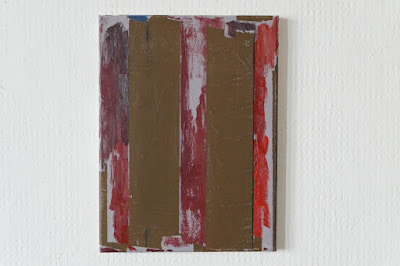








---
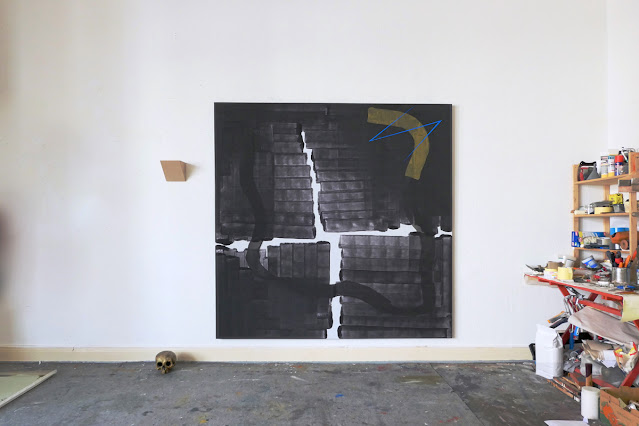 |
Carthago delenda est, 185x185cm (72.8x72.8"), gesso, pigments acrylic and oil paint on canvas, 2021. The little Halloween staging came afterwards, while thinking to the unavoidable epigones and gravediggers of modernity (disguised devotees) whose names i will refrain from mentioning since the list is too long and because it would bring them some free ad. Last pic, the head from a bust of Cato the Elder, roman politician to whom i owe my title. It has been said that he repeated this formula at the end of every speech he gave in the Senate, regardless of the subject of the speech: 'Carthage must be destroyed'. And, hey, i recently pointed out to me that my funny little stagings risked prejudicing the reception of the paintings by orienting their 'reading' beforehand. Likewise, i suppose, that this comment itself or any other modification of an ideal and neutral context. For sure, for sure (he thought), but just as i keep a certain mistrust of the proponents of pure painting, i wonder why the white walls of a gallery would be devoid of prior ideology, that is to say, would not already contain 'reading indications'. But (he thought), when you ask yourself if what you are doing is Just and Beautiful and Good, are you not just taking as a model and a term of comparison this immaculate space of idealistic appearance? Okay, and apart from these pseudo-polemical considerations (breaking open doors), i feel relatively happy that the yellow contributed to unveil, at the top right, the form and the counterform, and with the absence of texture and the particular quiet luminosity of the white, which actually isn't a white, but an off-white.

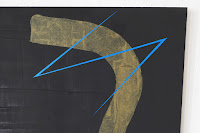

---
 |
| Achab, 170x170x4cm (67x67x1.6"), acrylic paint and oil on canvas. |
---
 |
| At work on tarps, 2018-2020. |
---
 |
A fanlight on the slab, 170x170x4cm (67x67x1.6"), acrylic paint on canvas, and some recent various notes that I relate and do not relate. . The interesting thing about sewing is that the thread disappears through a hole.
. There are some ways to deny your own ignorance; among others, to rely on belief, at random, to science.
. Slow down the transient to immobility, but maintaining the representation of the movement.
. The connection between grainy and pimply is not only a matter of size, but lies in its close relationship to the skin.
. Just because you sell a lot doesn't mean you're a good artist. Just because you sell very little does not mean that you are a good artist.
. And, from time to time, thinking back with a kind of diffuse gratitude to that very short dialogue found on IG a long time ago, below the pic of an big orange butterfly, where the person who posted it wrote: -"It is sooo wonderful!!! Do you know its name?" And someone answered: -"Georges?" |
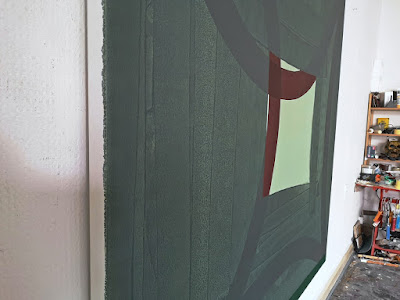

|
Yesterday evening, thinking about the order in which i will post the pics of this painting, i told myself that the hope of some 'beyond' has always crossed the field of painting, and this even in its most material elements, its most common processes, devices, results. For example transparency is not the opposite of opacity but the hinge on which the latter pivots, discovering an imaginary aperture. It is perhaps impossible to avoid this kind of overflow of the phantasy since it is linked to hope and that hope is nested everywhere. Moreover, in any field whatsoever, the more we refuse something and the closer we get to it, the more we refrain from resembling someone and the more we resemble him. The most radical and thoughtful pictorial practices, for example those which in the sixties and seventies did their utmost to move away from representation and the imaginary, quite often gave birth to another kind of representation, metaphysical, mystical, even downright religious. |









